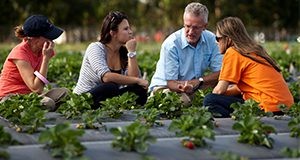Abstract
Florida Extension agents around the state are working to increase public agricultural awareness (Ag Awareness). This 5-page fact sheet outlines Florida’s recent Extension efforts in agricultural awareness and highlights future directions to coordinate and strengthen this work, offering ideas for best practices while avoiding unnecessary duplication. Written by Joy N. Rumble, Kathryn A. Stofer, and Libbie Johnson, and published by the Department of Agricultural Education and Communication, April 2016.
References
Carnevale, A. P., Smith, N., & Melton, M. (2011). STEM: Science, technology, engineering, mathematics. Washington, DC: Georgetown University Center on Education and the Workforce.
Duncan, D. W., & Broyles, T. W. (2006). A comparison of student knowledge and perceptions toward agriculture before and after attending a governor's school for agriculture. NACTA Journal, 50(1), 16-21.
Gauchat, G. (2012). Politicization of science in the public sphere: A study of public trust in the United States, 1974 to 2010. American Sociological Review, 77(2), 167-187. doi:10.1177/0003122412438225 https://doi.org/10.1177/0003122412438225
Goodwin, J. N., Chiarelli, C., & Irani, T. (2011). Is perception reality? Improving agricultural messages by discovering how consumers perceive messages. Journal of Applied Communications, 95(3), 21 -33. https://doi.org/10.4148/1051-0834.1162
Hillison, J. (1996). The origins of agriscience: Or where did all that scientific agriculture come from? Journal of Agricultural Education, 37(4), 8-13. https://doi.org/10.5032/jae.1996.04008
Miller, J. D. (2004). Public understanding of, and attitudes toward, scientific research: What we know and what we need to know. Public Understanding of Science, 13(3), 273-294. https://doi.org/10.1177/0963662504044908
Miller, J. D. (2010). The conceptualization and measurement of civic scientific literacy for the twenty-first century. In J. Meinwald & J. G. Hildebrand (Eds.), Science and the Educated American: A Core Component of Liberal Education. Cambridge, MA: American Academy of Arts and Sciences.
National Science Board. (2012). Science and Engineering Indicators 2012. Arlington, VA: National Science Foundation. Retrieved from http://www.nsf.gov/statistics/seind12/pdf/seind12.pdf
Powell, D., Agnew, D., & Trexler, C. (2008). Agricultural literacy: Clarifying a vision for practical application. Journal of Agricultural Education, 49(1), 85-98. doi: 10.5032/jae.2008.01085 https://doi.org/10.5032/jae.2008.01085
Thoron, A. C., & Myers, B. E. (2008). Agriscience: Sustaining the future of our profession. The Agricultural Education Magazine, 80(4), 9-11.
University of Florida. (2013). Shaping Solutions for Florida's Future: The UF/IFAS Extension Roadmap 2013-2023. Gainesville, FL.

